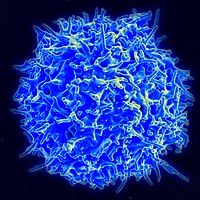
Photo from wikipedia
AIM To investigate the clinical features, treatment and prognosis of primary ocular adnexal mucosa-associated lymphoid tissue lymphoma (POAML). METHODS A retrospective analysis was performed on 64 patients with POAML who… Click to show full abstract
AIM To investigate the clinical features, treatment and prognosis of primary ocular adnexal mucosa-associated lymphoid tissue lymphoma (POAML). METHODS A retrospective analysis was performed on 64 patients with POAML who were admitted to the First Affiliated Hospital of Zhengzhou University from January 2006 to December 2018. RESULTS With a median follow-up of 61mo (range, 2-156mo), estimated overall survival (OS) rate and progression-free survival (PFS) rate at 10y reached 94.5% and 61.5%, respectively. Median OS time and PFS time were not reached. During this period, only 3 patients died, but none of them died directly due to disease progression. One patient (1.6%) developed transformation to diffuse large B-cell lymphoma (DLBCL). Of the 56 patients achieved complete remission after first-line treatment, 5 (8.9%) developed local and/or systemic relapse eventually. Patients ≥60y had significantly shorter PFS than younger patients (P=0.01). For patients with early stages (Ann Arbor stage I and stage II), univariate analysis confirmed that radiotherapy dose lower than 32 Gy were independently associated with shorter PFS (P=0.04). Other factors including gender, bone marrow involvement, the initial location of the disease, and the laterality were not associated with PFS. CONCLUSION The data from our center indicate that POAML has a slow clinical progression and has an excellent clinical outcome. Patients with POAML harbor a continual risk of relaps and transformation to aggressive subtype of lymphoma.
Journal Title: International journal of ophthalmology
Year Published: 2019
Link to full text (if available)
Share on Social Media: Sign Up to like & get
recommendations!